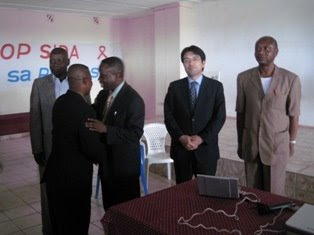
Lubumbashi university, March 18-21, 2009.
I and my boss from kochi university-japan,prof Suganuma, visited DRC to start a collaboration between our department of Environmental and occupational health, Kochi Medical school, with the faculty of medicine of University of lubumbashi in south Congo DRC. After meeting kinshasa university president and visited university hospital, hopital general, Ecuries clinic and clinique Ngaliema, we flew to Lubumbashi where we gave conferences and had meetings with local academical authorities. A need for a fruitful collaboration between our unversities was expressed by the staff of University of Lubumbashi, not only in the filed of occupational heatlth but other domains as well.
(Nous venions de sejourner en RD Congo pour une mission de service qui consistait a demarrer une collaboration entre notre departement de medecine environnementale et sante au travail d'une part,et la faculte de medecine de l'universite de Lubumbashi de l'autre.Avant cela, nous avons visite l'universite de kinshasa, les cliniques universitaires, ecuries clinic et la clinique ngaliema a Kinshasa,avant de nous rendre a lubumbashi. Sur place, nous avons tenu deux conferences et avons eu des rencontres et reunions avec les autorites acaemiques locales qui ont souhaite que la collaboration entre nos deux universites soit aussi elargie a d'autres facultes,autres que la medecine. Un article sur notre mission a ete publie par le journal 'le potentiel' du 21 mars 2009. L'accueil chaleureux et l'hospitalite congolaise etaient au rendez-vous. disons grand merci a nos hotes).
Dr Ngatu Roger Nlandu
PS: l'evenement insolite de ce bref sejour a ete le fait de retrouver dans la salle de conference, a l'universite de lubumbashi, un ancien collegue de ma promotion (UNIKIN) que j'ai vu en reve environs 1 mois avant de recevoir l'invitation du recteur.C'etait un grand temoignage pour mon boss qui, lui, en etait au courant depuis fevrier( voir photo ci-bas).



